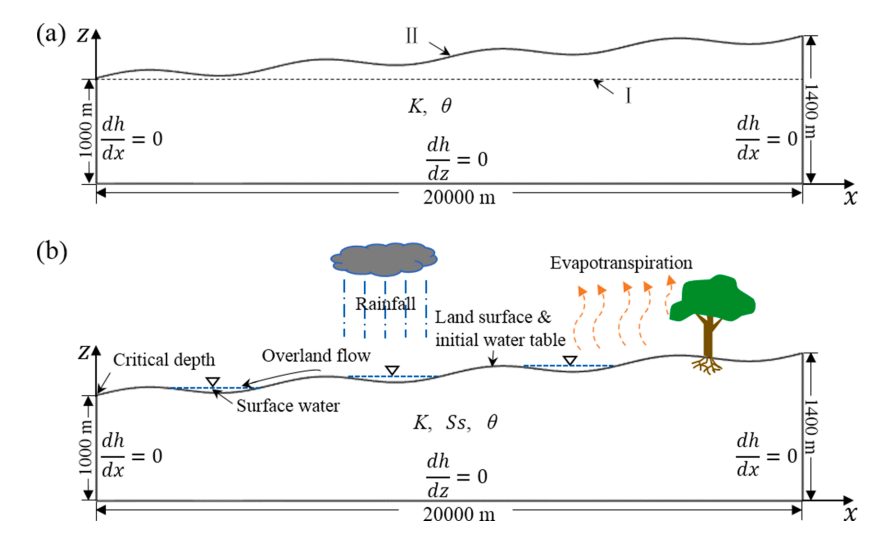Staff Research Highlight - Understanding topography-driven groundwater flow using fully-coupled surface-water and groundwater modeling
Dai, X., Xie, Y., Simmons, C. T., Berg, S., Dong, Y., Yang, J., Love, A. J., Wang, C., & Wu, J. (2021). Understanding topography-driven groundwater flow using fully-coupled surface-water and groundwater modeling. In Journal of Hydrology (Vol. 594, p. 125950). Elsevier BV. https://doi.org/10.1016/j.jhydrol.2020.125950
We’re pleased to highlight this publication, co-authored by Aquanty’s Steve Berg, which focuses on understanding the dynamics of topography-driven groundwater flow systems using fully-coupled surface–subsurface hydrologic modelling. This study addresses long-standing challenges in representing nested flow systems by simulating interactions between climate, topography, and groundwater without relying on potentially unrealistic boundary conditions.
CLICK HERE TO READ THE ARTICLE.
Previous models investigating topography-driven groundwater flow often used fixed, spatially-varying hydraulic heads as upper boundary conditions, which could lead to unreasonably high recharge rates due to the assumption of an unlimited water supply. This research instead employs HydroGeoSphere (HGS) to simulate both surface and subsurface hydrologic processes under transient climatic conditions. By using actual precipitation and evapotranspiration data as boundary conditions, the model generates more realistic water table elevations and groundwater exchange fluxes, allowing for a physically consistent representation of nested groundwater systems.
The researchers developed both a classic and a modified Tóthian model to simulate groundwater flow through homogeneous, isotropic aquifers. The classic model imposed spatially-variable hydraulic head at the top boundary, while the modified model allowed surface hydrology to evolve naturally based on topography by coupling surface and subsurface flow. Using HGS, they simulated 100 years of hydrologic activity using climate datasets representing both humid and semi-arid regions. Sensitivity analyses explored how varying hydraulic conductivity influenced water table undulation and the structure of nested flow systems.
“General patterns of the head and streamline distribution in the modified model remain largely similar to those in the original model. This similarity in modeling results suggests that HydroGeoSphere is capable of simulating nested flow systems under the current setting.”
Key findings showed that even under transient climatic inputs, large-scale groundwater systems tended toward dynamic equilibrium over the century-long simulations. Groundwater exchange fluxes with surface water varied significantly based on land surface inundation and water table position. For instance, smaller hydraulic conductivity values and wetter climates led to greater surface water inundation and more hierarchical nesting of groundwater flow, while higher conductivity and drier climates produced flatter water tables and more regionalized flow.
Figure 1. Conceptual models used to simulate: (a) pure groundwater flow (Section 2) and (b) fully-coupled surface-water and groundwater flow (Section 3). I and II in (a) are the top surface and the corresponding head boundary condition of the classic Tóthian model (Section 2.1). II is both the top surface and the corresponding head boundary condition of the modified Tóthian model (Section 2.2).
HydroGeoSphere proved essential in capturing these dynamics due to its ability to simulate coupled surface and variably saturated subsurface flows. Unlike traditional models, which risk breaking the causal relationship between head and flow, the fully-coupled HGS approach honors physical realism by allowing the water table to form organically from climatic forcing. This capability enabled the identification of features such as flow-through regimes and recharge-focused groundwater mounding—phenomena that are often missed in models with static boundary conditions.
This research provides valuable insights for groundwater modelling and water resource management, especially in regions where topography and climate interact to influence groundwater availability. By emphasizing the importance of causality and climate-driven hydrologic processes, the study advocates for broader adoption of integrated modelling platforms like HGS to more accurately reflect real-world conditions in groundwater systems.
Abstract:
Numerical models with spatially-varying head as top boundary conditions were used in previous studies to understand topography-driven groundwater flow. The head boundary conditions could cause artifacts of extremely large, but unrealistic recharge rates owing to unlimited supply of water. This study adopted a fully-coupled surface–subsurface hydrologic modeling approach to simulate transient topography-driven groundwater flow and also surface-water flow under homogeneous and isotropic settings. Two 100-year climate datasets and five hydraulic conductivities (K, 0.01–100 m/d) were tested in numerical experiments. In the base case with a wet climate (annual precipitation 1696 mm/y) and K of 1 m/d, groundwater head at two different locations close to both lateral boundaries fluctuates only within 5.1 m and 9.6 m, respectively, during the 100-year period. Despite the local water table fluctuations caused by the variability in the climatic record, large-scale groundwater flow systems can be assumed in dynamic equilibrium provided stationary climate. Long-term average exchange fluxes are spatially constant and limited by precipitation infiltration when surface water is absent, whereas they vary from positive to negative values (i.e., recharge to discharge) spatially when surface water is present. Sensitivity analysis suggests that wetter climate and smaller K lead to more inundation of the land surface, stronger hierarchical nesting of groundwater flow systems and more variable exchange fluxes. Overall, our first fully-coupled modeling of topography-driven groundwater flow implies that attention must be paid to causality between head and flow, and climatic record as boundary conditions may be more appropriate due to its relaxed manner.

